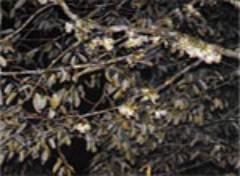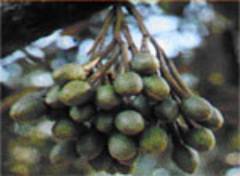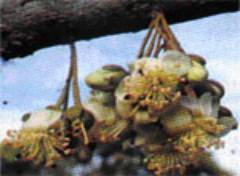Durian inflorescences are usually borne on primary and secondary branches, consisting of 40-50 flowers (Fig. 1,2,3) .

Fig. 1. Durian flowers on primary and secondary branches

Fig. 2. Young buds

Fig. 3. Blooming flowers
Durian usually flowers heavily but only about 1% of them survive to maturity. Fruit mortality may be due to competition in space or photosynthates. Durians generally flower once a year after undergoing a dry spell of 1-2 months. The flowering and fruiting seasons are almost regular every year.
Durian flowers are nocturnal in nature. They usually start opening in the late afternoon but the anthers do not produce pollen until later at dusk. The stigma is receptive about 2 hours before the flower opens, reaches its peak at midnight and declines the next morning.
Usually durian flowers are pollinated by nocturnal pollinating agents such as small bats (Eonycterus spalee and Macroglossus minimus), wasps (Apis dorsata) and a few species of ants.
Shortly after being pollinated, all flower parts except the ovary and the filament drop off. The ovary enlarges and the filament dries up. If pollination is complete, fruitlets are formed from the ovary . In the absence of pollination, the ovary drops 7-10 days after anthesis . Durian fruits mature 90-130 days after anthesis . |

